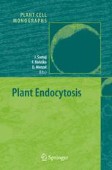Search
Search Results
-
Auxin Transport and Recycling of PIN Proteins in Plants
Polar transport of the phytohormone auxin is mediated by plasma-membrane and endosome localized carrier proteins. PIN proteins are the best...
-
Rab GTPases in Plant Endocytosis
The Rab family is part of the Ras superfamily of small GTPases. In eukaryotes Rab GTPases are present as members of gene families, and the...
-
MDR/PGP Auxin Transport Proteins and Endocytic Cycling
Auxin is an essential regulator of plant growth and development. Polarized transport of auxin is responsible for apical dominance, tropic growth,...
-
Methods and Molecular Tools for Studying Endocytosis in Plants---an Overview
Proteins of the endocytosis machinery in plants, such as clathrin and adaptor proteins, were isolated and characterized using combinations of...
-
Tip Growth and Endocytosis in Fungi
Recent advances in molecular cell biology have provided new insights into different cellular processes that all turn out to contribute to...
-
Transcriptome analysis in abiotic stress conditions in higher plants
Drought, high salinity, and low temperature are major environmental factors that limit plant productivity. Plants respond and adapt to these stresses...
-
Signal transduction in plant cold acclimation
Temperate plants respond to low temperature by activating a cold acclimation program leading to enhanced tolerance to freezing temperatures. This...
-
Sensors of abiotic stress in Synechocystis
Systematic mutagenesis of histidine kinases in combination with DNA microarray technology has allowed us to identify sensors for cold, hyperosmotic...
-
Plant responses to heat stress
The heat stress response is characterized by inhibition of normal transcription and translation, higher expression of heat shock proteins (hsps) and...
-
Abscisic acid signalling
Signalling of abscisic acid (ABA) in plants is characterized by an amazing number of secondary messengers that are part of the pathway or modulate...
-
Plant salt tolerance
Soil salinity adversely affects crop productivity and quality. The success of breeding programs aimed at salinity tolerant crop varieties is limited...
-
SNAREs in Plant Endocytosis and the Post-Golgi Traffic
In eukaryotic cells, the transport vesicles carry various cargo proteins from a donor compartment to a target compartment, and discharge the cargo...
-
Sterol Endocytosis and Trafficking in Plant Cells
Structural sterols are integral components of biological membranes. They regulate membrane permeability and fluidity, and they influence the...
-
Plant Vacuoles: from Biogenesis to Function
The plant vacuolar system is far more complex than originally expected and multiple sorting pathways leading to various types of vacuoles can be...
-
Endocytosis in Guard Cells
Stomatal movement requires large and repetitive changes to cell volume and consequently surface area. These alterations in surface area are...
-
Endocytosis and Actomyosin Cytoskeleton
Mutual interactions between actin and endocytic assembly machineries are essential for successful clathrin-mediated endocytosis in yeast and...
-
Endocytosis and Membrane Recycling in Pollen Tubes
In plants, tip-growing cells are an ideal system to investigate signal transduction mechanisms and, among these, pollen tubes are one of the...
-
Plant Prevacuolar Compartments and Endocytosis
Prevacuolar compartments (PVCs) are membrane-bound organelles mediating protein traffic from both Golgi and plasma membrane to vacuoles in...
-
Molecular responses of higher plants to dehydration
A massive amount of data has been accumulating on the molecular responses of plants to water deficit. In plants, dehydration activates a protective...
-
Heavy metal signalling in plants: linking cellular and organismic responses
Heavy metals are required in plants as essential micronutrients or act as toxic compounds. How do plants perceive heavy metals and which signalling...
